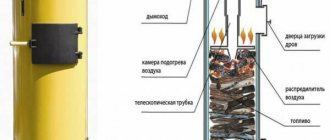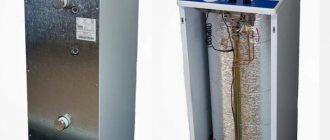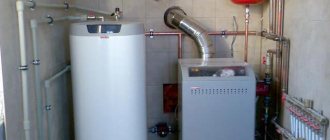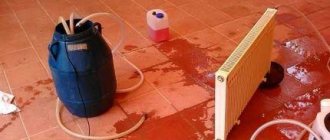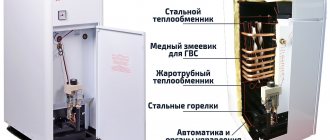In the 60-70s, gasification of the country began, the logical continuation of which was the development of a gas boiler for autonomous heating. It was designed for use in remote and small settlements lacking infrastructure.
The creation of such equipment was a revolution in the organization of everyday life. And today, AGV heating is still used in rural areas as an alternative to centralized heating.
DEVICE AND PRINCIPLE OF OPERATION.
The device consists of the following components and parts: a heat exchanger tank, a main burner, an ignition burner unit with a thermocouple and an ignition electrode installed in it, a combined gas valve (multifunctional regulator), a draft stabilizer, and cladding parts.
In the upper part of the heat exchanger tank there is a thermostat sensor connected by a capillary tube to the actuator of the thermostatic valve (bellows-thermal balloon system) and a thermometer sensor
A special feature of the design of the 630 EUROSIT combination valve is the presence of a device for stabilizing the gas outlet pressure, as well as the combination of valve control in one handle with the designation of positions by the corresponding symbols and numbers at its end and an indicator on the valve cover. The dependence of the temperature of the heated water on the position of the control handle scale is presented below:
The operating principle of the temperature controller is based on the expansion of liquid when heated. The working fluid, heated in the sensor (thermal cylinder) from the water in the tank - heat exchanger, heated by the combustion of natural gas, expands and flows through the capillary tube into the bellows, which converts the volumetric expansion into linear movement of the mechanism that drives the system of two valves (instantaneous and metering). ). The design of the mechanism provides protection against thermal overload, which protects the bellows-thermal cylinder system from damage and depressurization.
- When setting the required water temperature in the device using the control handle to increase, first the instantaneous (click) valve opens, then the dosing valve.
- When the water temperature in the apparatus reaches the set value, the dosing valve smoothly closes, switching the main burner to the “low gas” mode.
- When the temperature rises above the set value, an instantaneous (click) valve is activated, completely shutting off the gas to the main burner.
- In the absence of draft in the chimney, the gases leaving the firebox heat the draft sensor, the sensor is triggered, opening the normally closed contacts of the thermocouple circuit. The electromagnetic (inlet) valve closes and blocks the access of gas to the main and ignition burners. The draft sensor is designed to be activated during a period of no draft for at least 10 seconds.
- When the gas supply from the network is stopped, the pilot burner instantly goes out, the thermocouple cools down, and the solenoid valve closes, blocking gas access to the main and pilot burners. When the gas supply is restored, the passage through the apparatus is completely blocked.
- When the gas pressure in the network decreases below 0.65 kPa, the gas pressure at the ignition burner will also drop, and the emf of the thermocouple will decrease to a value insufficient to hold the valve. The solenoid valve will close and block gas access to the burners.
SAFETY INSTRUCTIONS
Persons who have examined this passport are allowed to service the device.
Installation and operation of the devices must comply with the requirements of the “Rules for the design and safety of operation of hot water boilers, water heaters and steam boilers with excess pressure”, as well as the requirements of the “Safety Rules for Gas Distribution and Gas Consumption Systems. PB 12 - 529", approved by the State Mining and Technical Supervision of Russia.
The operation of the devices must be carried out in accordance with the “Fire Safety Rules for residential buildings, hotels, dormitories, administrative buildings and individual garages PPB - 01 - 03”.
Operation of the device is only permitted with properly functioning automatic safety and thermal control.
Gas safety automatics must provide:
- Reducing the gas supply when the water temperature in the heating system reaches the set value.
- Shutting off the gas supply to the main burner when the set heating temperature is exceeded.
- Turning off the gas supply to the device in the following cases:
- when the gas supply to the device is stopped (within no more than 60 seconds);
- in the absence of draft vacuum or in the boiler furnace (for a period of no less than 10 seconds and no more than 60 seconds);
- when the pilot burner flame goes out (within no more than 60 seconds).
When operating the device, the hot water temperature should not exceed 95 °C.
Prohibited:
- operate the device with the heating system partially filled with water;
- use other liquids instead of water as a coolant**;
- install shut-off and control valves on the supply line and pipeline connecting the heating system to the expansion tank;
- operate the device if there is a gas leak through the gas pipeline connections;
- use an open flame to detect gas leaks;
- operate the device if there is a malfunction of the gas network, chimney or automation;
- independently eliminate malfunctions in the operation of the device;
- make any design changes to the apparatus, gas pipeline and heating system.
When the device is not working, all gas valves: in front of the burner and on the gas pipeline in front of the device, must be in the closed position (the valve handle is perpendicular to the gas pipeline).
Any malfunctions when operating the device on gas must be immediately reported to the emergency service of the gas operating company.
If gas is detected in the premises, you should immediately stop supplying it, ventilate all premises and call emergency or repair services. Until the malfunction is eliminated, it is prohibited to light matches, smoke, or use
** It is allowed to use household coolant “Olga” (manufacturer: ZAO Organic Products Plant) according to the instructions for use. After a period of operation, the coolant must be drained and disposed of.
The manufacturer reserves the right to make changes to the design and appearance of the product. This technical documentation may differ from the description above; see the operating manual enclosed with each boiler upon purchase.
Some recommendations for installing AGV systems
Important ! The boiler room can be located anywhere, but not in a residential area. It is extremely necessary to provide for the possibility of air inflow and exhaust in the furnace.
Installation of equipment in accordance with certain technical standards and safety requirements can be carried out by a specialized organization. The exact implementation of all rules, instructions and recommendations for installing the boiler is checked by a representative of the gas inspection.
Important! The inspector will give permission to connect the equipment to the main line if all the requirements of the design documentation and safety are fully met.
| AGV-80 | 7 kW | up to 60 m² | 80 l | 75% | 90˚ | 85 kg |
| AOGV-23.2 | 23.2 kW | up to 200 m² | 35 l | 89% | 95˚ | 55 kg |
| Enlarge photo |
|
What does the automation system for gas heating boilers AOGV consist of?
A standard automatic system must have several basic elements.
Ignition elements. In modern systems there is no burning splinter. The pilot burner is ignited by a piezoelectric element, which produces electrical energy as a result of mechanical pressure on the crystal. There are systems in which you need to open the gas supply valve with one hand and press the piezo ignition button with the other. In the most modern boilers, one button is responsible for the operation of both processes. The gas valve is then controlled in one of two ways:
- Due to the voltage that occurs when the thermocouple heats up.
- Due to heating of an additional thermal generator (more often used in imported boilers).
Automation of gas boilers AOGV most often operates using thermocouple energy.
In both cases, the generated energy creates a voltage that acts on the gas valve coil. It remains open, providing gas supply, as long as the gas burner is burning.
Thermoregulation system. These elements control the water temperature. They consist of a temperature sensor and a valve system that shuts off the flow of gas when the set temperature is reached. In the most modern boiler models, a room thermostat has been added to the control circuit, which, depending on the room temperature, sends a signal and the need to close or open the gas supply valve.
Control elements for efficient and safe removal of combustion products. This is a draft sensor that is mounted in the chimney. Wires connect the draft sensor to the gas valve. If there is no optimal draft, a signal is sent to the valve, it closes and stops the gas supply.
Automation for gas heating boilers does not allow you to turn on the gas supply if the equipment’s performance indicators go wrong or the slightest breakdown or depressurization of pipes occurs.
Additional elements and automation capabilities
In some models, automatic equipment for gas boilers AOGV is equipped with a thermostat that provides regulation of gas flow. The reason for reducing the intensity of work may be an increase in temperature outside or a signal from the thermostat in one of the rooms that the maximum permissible temperature has been exceeded.
Models that are installed in the Smart Home system offer the possibility of remote control of heating modes.
A modern, properly installed and adjusted automatic system on heating equipment helps reduce heating costs by 40%.
Owner reviews about the model
Let's consider what the owners themselves say about the Zhukovsky AOGV 23 boilers:
In the 60-70s, gasification of the country began, the logical continuation of which was the development of a gas boiler for autonomous heating. It was designed for use in remote and small settlements lacking infrastructure.
The creation of such equipment was a revolution in the organization of everyday life. And today, AGV heating is still used in rural areas as an alternative to centralized heating.
Distinctive characteristics of boilers
The Universal and Economy model boilers are especially popular among buyers. There are significant differences in the technical characteristics of AOGV 116 of these series. The Economy version is manufactured using Russian automation; this unit can be controlled using a solenoid valve and a temperature control knob. A draft sensor and a thermocouple are connected to them - one of the most important elements of the device.
The boiler AOGV 11.6 series Universal is produced on the basis of Italian automatic equipment
. The unit is distinguished by the presence of an automatic thermostat and piezo ignition. The device can be turned on by pressing just one button, and there is no connection to electricity networks.
Heater parameters
Operating characteristics of Zhukov boilers
When choosing heating equipment, you need to pay attention to its technical characteristics:
- rated power: 11.6-29.0 kW;
- fuel consumption: main - 1.9-3.56 cubic meters/hour, bottled - 0.86-1.21 kg/hour;
- heating area: 120-400 sq.m.;
- Efficiency: 85-90%.
The body can be rectangular (for high-power models) or cylindrical.
Features of AOGV
The abbreviation AOGV simply stands for gas-fired water heating apparatus. The number after the letters indicates the power of the model, that is, the AOGV 116 boiler is an 11.6 kW unit, respectively.
The technical characteristics of AOGV 11 6 3 indicate that the boiler is intended for heating a private residential house, garage or small utility room. The model is presented only in a floor-standing version; household units have a power ranging from 11-29 kW. The fuel used to operate the device is natural gas.
At the bottom of the boiler there is a heat exchanger, under which there is a gas burner. This is what heats the water. The unit can be converted
for the use of liquefied gas. High quality steel is used to make the device body. The heat exchanger is made of tubes, which ensures a high efficiency of the device.
In this video you will learn how to light a boiler AOGV 11.5
On the back there are two fittings for inlet and outlet. The top one works with a straight line, the bottom one with a reverse line. The upper part of the body is attached to the chimney; its diameter must exceed 12 cm. Manufacturers produce two types of boilers - single- and double-circuit boilers. The latter are intended not only for heating, but also for heating water.
Nuances of operation
When using gas equipment from ZhMZ, you should know: the burner, when starting, creates noise - cotton. In some modifications it is minimized - it turns on more smoothly.
The chimney is installed outside the residential premises. The diameter of the chimney is 14 cm. Under its pipe there is a container for collecting soot, which needs to be cleaned from time to time.
Floor-standing devices are installed in separate rooms, on the lower level of the building. The new equipment comes with instructions, connection diagram and technical data sheet.
Advantages and disadvantages
Among all the characteristics of the AOGV 11.6 boiler, its main advantages and disadvantages are highlighted. There are several main advantages:
- the possibility of using natural and liquefied gas as fuel;
- energy independence;
- compatibility with any system material;
- uninterrupted operation with natural and forced circulation.
The unit can be connected to any heating system. It can be made of cast iron, metal-plastic, polypropylene or steel. That is why such boilers are considered universal. There are also some disadvantages of the devices:
- the Economy series is made using outdated parts;
- in the event of a breakdown, it is difficult for craftsmen to find suitable parts;
- Compared to other units, this version has a fairly high price.
Since Economy boilers are produced using elements made according to samples of Soviet engineers, they are very difficult to replace during repairs. It's better not to buy the cheapest options
, but opt for the Universal. Although, in the case of purchasing models with imported parts, difficulties also arise, since they are not available on the domestic market. You will have to order replacements for damaged elements directly from the manufacturer. The average cost of boilers is 11-17 thousand rubles, which significantly exceeds the price of units from other manufacturers.
Gas boilers AKGV
The abbreviation of Borinsky gas equipment of the AKGV series stands for a combined gas and water circuit apparatus. In fact, this is the same AOGV only with a built-in second coil for the DHW system. Features of the line:
- leaky combustion chamber;
- two coils – heating + hot water supply;
- non-volatile automation.
This line is also equipped with sensors that prevent overheating of the coolant, turn off the boiler if the draft in the chimney disappears or the wick flame goes out. A gas pressure stabilizer and a mechanical cleaning filter are installed, which has a positive effect on the operation of the heater. The burner is made of stainless steel, both coils are copper. The characteristics, operating principle of the boiler and protective mechanisms are the same as in the Borino AOGV line of gas equipment. Fuel is only natural gas. All models are floor-standing.
The DHW circuit requires special attention. The product data sheet states that water for household needs should not be allowed to be heated directly from the water supply. That is, in transit, such as in parapet boilers, it will not be possible to heat water. Because of this, scale will form on the walls of the coil, as a result of which heat transfer will decrease, the nominal flow will decrease (up to the complete cessation of circulation), and the coil will burn out. There is only one way out - installing an indirect heating boiler in the heating system.
AKGV series
Floor-standing boilers with a double-circuit heating system are also presented here. Boilers of this series require high-quality ventilation, which will remove combustion products, and a separate room. True, as reviews of models in this series show, you can also buy a gas boiler for installation in the kitchen.
- The burner power in these units varies from 11.5 to 29 kW. The most popular model has a power of 17 kW and heats a room of 150 square meters. meters
- The boiler is equipped with a bithermic heat exchanger - a coil is installed inside the tank, which is responsible for heating the water to the desired temperature
- The burner of the device has anti-corrosion properties
- Heating equipment is equipped with a thermostat, temperature control system and control of gas supply and draft in the system
Also, the AKGV series is distinguished by the fact that the outer walls do not heat up during operation, and during sudden gusts of wind the draft will not disappear thanks to a special stabilizing element.
You can buy a Borinsky heating boiler of the AKGV series for $250, and you can buy Borinsky gas heating boilers with a higher power of 23 kW for $360. What do reviews say about the powerful heating boiler model AKGV 23?
Anastasia, 32 years old:
I’m glad that this model is non-volatile; constant power outages are always a problem for parents. It also heats the water quite well, but I can’t say that the pressure is enough for all needs – it’s enough to wash the dishes.”
3. AOGV series - here are gas single-circuit boilers designed for space heating. Devices in this series are floor-standing units that run on natural gas.
AOGV models are manufactured in a cylindrical body and are represented by several “subseries” - an economy version with a Russian-made control unit, a universal device with a control unit from Italian brands, and a comfortable unit, where the automation is presented by a German manufacturer.
- Borinsky AOGV floor-standing gas boilers have thermal power from 11.5 to 29 kW.
- Designed for heating rooms from 40 (at minimum power) to 250 sq. meters (maximum boiler power).
- Gas boilers are equipped with an automatic system for stopping the gas supply in the absence of draft and ignition on the burner.
- Equipped with a thermostat with a temperature range up to +95 degrees.
You can buy a Borinsky boiler of the AOGV series for 220 USD. – such a model will have minimal power; a unit for a large house with maximum power will cost $450-490. Let's look at the reviews of the mid-price model with a power of 23 kW.
Alexander, 37 years old:
In general, I bought a model with Italian automatic equipment for my 150 square meters. I want to say that the efficiency is really about 90%, and the gas consumption is small - about 1.7 kg/hour (cylinder). I’m happy with the device and I couldn’t be happier for six months now.”
4. The KOV series are single-circuit floor-standing boilers, which are distinguished by high power and are designed for heating large rooms.
- Borinsky KOV boilers have a power from 30 to 63 kW;
- Equipped with automatic equipment from an Italian manufacturer;
- Designed for heating areas from 250 to 750 square meters. meters;
- Gas boilers are equipped with a protection system in the absence of draft, gas supply interruption and absence of an igniter on the burner.
You can buy a Borino boiler with a power of 30 kW for 600-660 USD, a boiler with a power of 50 kW for a room of 500 square meters will cost 820-860 dollars.
Choosing a Borino boiler
Before you buy a Borino gas boiler, decide what you need it for - will it only perform a heating function, or do you need a double-circuit model.
- Look at the power - if your house is insulated, you can choose a boiler commensurate with the area of the house. If your house is “cold”, take a model with “power reserve”
- Look at the automation - all floor-standing boilers are equipped with a protection system, but the automation itself can be of domestic or foreign production
- Look at the combustion chamber and air outlet - the chamber can be closed or open, run on natural gas or from a cylinder. Some models may require replacement of injectors to operate on liquefied gas.

